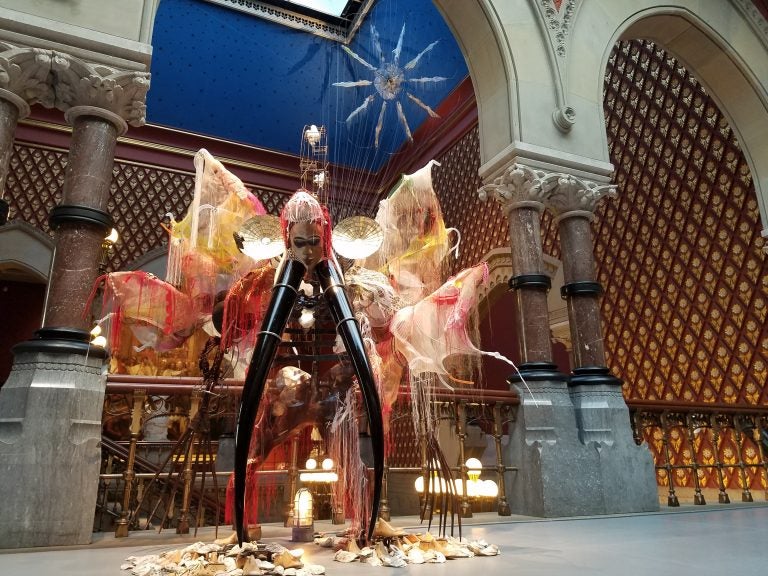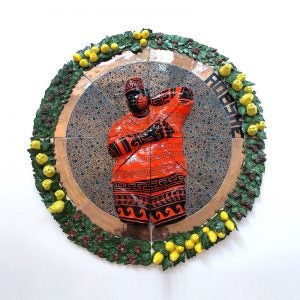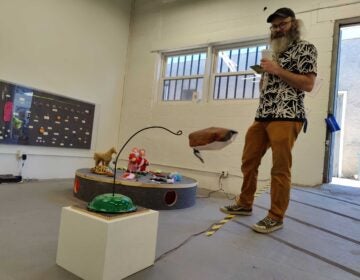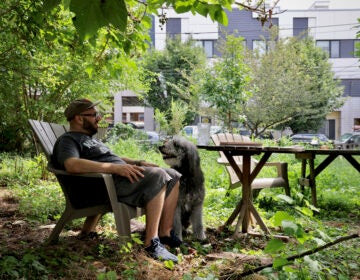Philadelphia craft events giving rise to art as activism
CraftNOW, a series of events built around the Philadelphia Craft Show, presents artists as activists.

"Viola, from New Orleans..." by Rina Banerjee is on display at the Pennsylvania Academy of the Fine Arts. (Peter Crimmins/WHYY)
An exhibit at Old City’s Clay Studio, as well as a symposium put on by CraftNOW, are putting a focus on “Making a Difference.”
The symposium will feature panels of artists, curators, and scholars talking about how craft is used for social and political activism.
Clay Studio Curator Jennifer Zwilling, who also sits on the CraftNOW board, said craftwork is uniquely suited to appeal to hearts and minds.
“When you have a direct connection to an object – like a bowl or a chair – you have an extremely intimate relationship,” she said. “There is a lot of power possible in that object to infuse concepts of what people are worried about in their personal lives, like social issues and political issues.”
One of the artists who has taken up this approach to activism is Roberto Lugo, who grew up in Philadelphia’s Kensington neighborhood. As a Puerto Rican kid surrounded by the drug trade and crushing poverty, he saw no opportunity to be successful in anything.
“When I was in grade school and someone said, ‘You could be president, you could be a lawyer, you could be a doctor’ — even at 5 years old, I was, like, no,” he said. “I don’t know anyone who has anything other than a factory job.”
Lugo likes to say that pottery saved his life. In fact, “Pottery saved my life” is the title of the keynote address he’ll deliver at CraftNOW, a series of craft-related exhibitions and workshops put on around the city for a month. He will tell the story of how he discovered pottery when taking a class at a community college in Florida.
At first the attraction was a class that didn’t require him to write because he lacked confidence in his ability to write. So pottery became the way he articulates his life.
“When I first started making things on a wheel, I saw it as a machine that made round things. So one of the first things I made was a ceramic fire hydrant, because — when our water was shut off — my dad and I would shower at the fire hydrant,” he said. “Other people in class were making bowls and teapots. I’d never used a teapot in my life. Where I come from, people don’t come over and drink tea.”

Lugo learned to use ceramics to include black and brown faces into art history. He adopts classic pottery forms from European and Asian antiquity – porcelain teapots and delft plateware – and makes them with imagery of urban life: graffiti, food stamps, and hoodies.
He has a piece in the Clay Studio’s “Making a Difference” show that is based on a classic clay relief form by Renaissance artist Giovanni della Robbia, who made rounded friezes edged with floral shapes around a figure in the middle.
Lugo’s figure is himself, dressed in orange and black clothes reminiscent of figures on ancient Greek vases. Look closer, and it’s a prison jumpsuit.
“When people in the neighborhood where I grew up see black and orange, they think prison outfits,” he said. “If you say black and orange in a craft sense, it’s Greek pottery.”
A longstanding question
Another topic to be discussed during CraftNOW is an issue that’s inspired arguments for at least 100 years: Where is the line between art and craft? It has blurred so much that many artists don’t see the line at all – and yet the event is called a craft show, not an art show.
“There are a lot of things not considered to be art, which is high art in other places,” said Rina Banerjee, whose art lives in a global space where cultural signals are crossed.
Feminism, for example, is not the same in China as it is in Saudi Arabia as it is in France. It’s a topic Banerjee revisits a lot.
Banerjee, who was born in India, now lives in New York City. Right now the Pennsylvania Academy of the Fine Arts has her first major retrospective, “Make Me a Summary of the World.” She will also appear in the CraftNOW symposium talking about how craft and folk arts complicate the perceived hierarchy of high and low art.
Like the tendrils that snake around her drawn figures — or like a contemporary contagion infecting art history — Banerjee’s works have spread through all the galleries of PAFA’s historic Furness building. Her palette is a kitchen sink of animal horns, copper wire, feathers, doll heads, dried mushrooms, glass beads, cowrie shells, electric lights, steel mesh, blueprints of building ventilation systems and apple gourds.
And plastic. Lots and lots of plastic.
In college, Banerjee studied materials science, specializing in polymers. She worked for a brief time as a plastics engineer at Pennsylvania State University, consulting on applications for NASA.
Plastic, she says, is the stuff that binds us together.
“I was studying and making these engineering balloons for the weather, and we had all this high technology for plastics, but it’s an everyday thing. It’s what we find in every household,” she said. “It’s clearly something we encounter in everyday life. It reflects the world.”
Banerjee does not use plastic to make her work look clean and shiny. Her pieces tend to be messy, chaotic, and organic. It’s not always clear what the pieces are. The titles of the works often don’t clarify; the long, rambling names she gives her pieces do more to confound meaning than enlighten.
“The non-knowing allows people to interpret,” she said. “They are forced to do the work of interpreting the work.”
That might be one of the reasons her work is seen as art.
WHYY is your source for fact-based, in-depth journalism and information. As a nonprofit organization, we rely on financial support from readers like you. Please give today.





